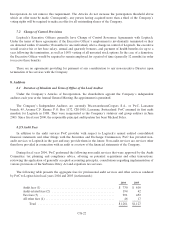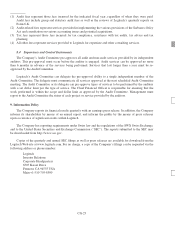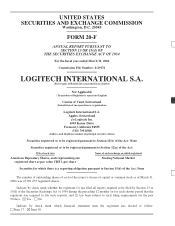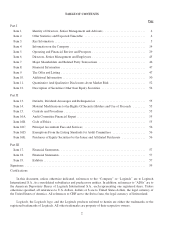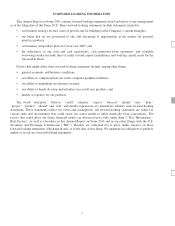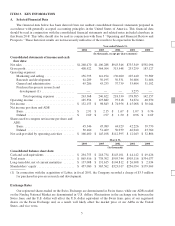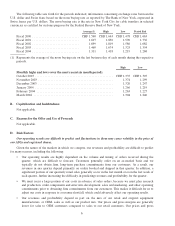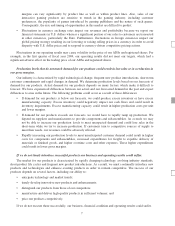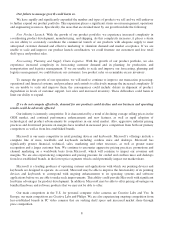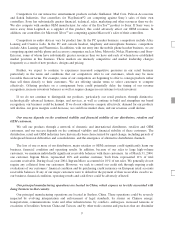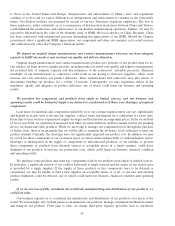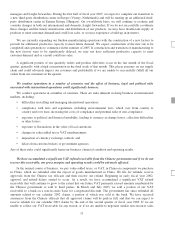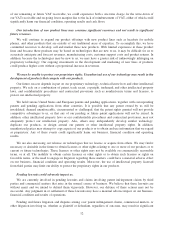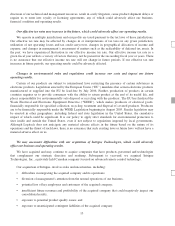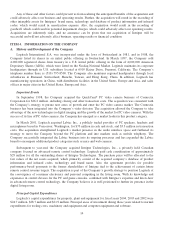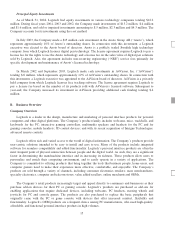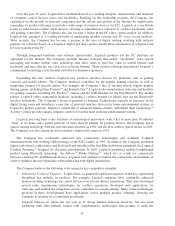Logitech 2004 Annual Report Download - page 45
Download and view the complete annual report
Please find page 45 of the 2004 Logitech annual report below. You can navigate through the pages in the report by either clicking on the pages listed below, or by using the keyword search tool below to find specific information within the annual report.
margins can vary significantly by product line as well as within product lines. Also, sales of our
interactive gaming products are sensitive to trends in the gaming industry, including customer
preferences, the popularity of games introduced by gaming publishers and the nature of such games.
Consequently, the size and timing of opportunities in this market are difficult to predict.
• Fluctuations in currency exchange rates impact our revenues and profitability because we report our
financial statements in U.S. dollars whereas a significant portion of our sales to customers are transacted
in other currencies, particularly the Euro. Furthermore, fluctuations in foreign currencies impact our
global pricing strategy resulting in our lowering or raising selling prices in a currency in order to avoid
disparity with U.S. dollar prices and to respond to currency-driven competitive pricing actions.
Fluctuations in our operating results may cause volatility in the price of our ADSs and registered shares. For
example, in the first quarter of fiscal year 2004, our operating results did not meet our targets, which had a
significant adverse effect on the trading price of our ADSs and registered shares.
Production levels that do not match demand for our products could result in lost sales or in a reduction in
our gross margins.
Our industry is characterized by rapid technological change, frequent new product introductions, short-term
customer commitments and rapid changes in demand. We determine production levels based on our forecasts of
demand for our products. Actual demand for our products depends on many factors, which make it difficult to
forecast. We have experienced differences between our actual and our forecasted demand in the past and expect
differences to arise in the future. The following problems could occur as a result of these differences:
• If demand for our products is below our forecasts, we could produce excess inventory or have excess
manufacturing capacity. Excess inventory could negatively impact our cash flows and could result in
inventory impairments. Excess manufacturing capacity could result in higher production costs per unit
and lower margins.
• If demand for our products exceeds our forecasts, we would have to rapidly ramp up production. We
depend on suppliers and manufacturers to provide components and subassemblies. As a result, we may
not be able to increase our production levels to meet unexpected demand and could lose sales in the
short-term while we try to increase production. If customers turn to competitive sources of supply to
meet their needs, our revenues could be adversely affected.
• Rapidly increasing our production levels to meet unanticipated customer demand could result in higher
costs for components and subassemblies, increased expenditures for freight to expedite delivery of
materials or finished goods, and higher overtime costs and other expenses. These higher expenditures
could result in lower gross margins.
If we do not timely introduce successful products our business and operating results could suffer.
The market for our products is characterized by rapidly changing technology, evolving industry standards,
short product life cycles and frequent new product introductions. As a result, we must continually introduce new
products and technologies and enhance existing products in order to remain competitive. The success of our
products depends on several factors, including our ability to:
• anticipate technology and market trends;
• timely develop innovative new products and enhancements;
• distinguish our products from those of our competitors;
• manufacture and deliver high-quality products in sufficient volumes; and
• price our products competitively.
If we do not execute these successfully, our business, financial condition and operating results could suffer.
7



